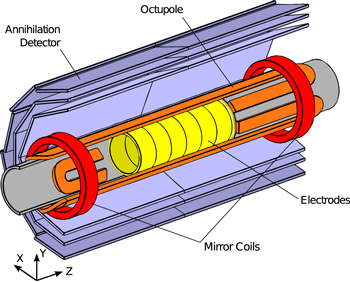Antimatter, often the subject of science fiction on account of its conversion to energy when it comes in contact with matter, is very real and at the center of one of the great mysteries of physics. Current theory would predict that the universe should have been created equal parts matter and antimatter, however the apparent lack of antimatter observed today is in contradiction to this. Precise measurements on the properties of antihydrogen (the antimatter version of hydrogen), from its ‘colour’ to its free-fall behavior in drop test to measure ‘antigravity’, offer precise, direct, and model-free opportunities to test the underlying assumptions of our present theories, and help lead to way to resolving the problem of excess matter.
Over 40 years ago, researchers had identified the advantages of making these sorts of measurements on antihydrogen atoms. At the time, and lacking a ready-source of this exotic atom, physicists began a long line of investigation into the production and preparation of low energy antimatter in general and ultimately antihydrogen. The first production of took place in a high energy fixed target experiment at CERN in 1996, with the inflight production and detection of 9 relativistic antihydrogen atoms.
In order to actually study this and other antimatter systems, CERN built and commissioned the Antiproton Decelerator (AD) in 1999 to produce copious antiprotons for use in low energy experiments such as those involving antihydrogen. Shortly thereafter, the production of low energy antihydrogen was reported in 2002 by the ATHENA collaboration. It proved surprisingly difficult to transform this antihydrogen source into a usable platform for measurements, but in 2010, ALPHA reported on the first trapping of antihydrogen for spectroscopic studies. A year later, they also performed the first measurement on it by directly driving an atomic hyperfine transition in 2011, a technique that is an important milestone in performing any precise measurements with this antiatom.

Schematic of the central part of the ALPHA Apparatus showing the electrodes (yellow) the neutral trap magnets (red and orange) and the annihilation detector (blue). The solenoid providing the main axial Penning trap field is not shown.
Today, at the AD hall at CERN, the activity in this field is growing, with a number of experiments racing towards the first precise comparisons of matter and antimatter and with more on the way given the anticipated arrival of ELENA, a major upgrade to the AD complex. It’s an exciting time in this field, as any minute difference found between the behaviour of matter and antimatter would have profound and far-reaching impact to all areas of physics. The article “Physics with antihydrogen”, written by CI expert Dr. Will Bertsche, offers a comprehensive review of the current state of this research as well as the future directions of the collaborations involved in this activity.
Find out more: http://iopscience.iop.org/article/10.1088/0953-4075/48/23/232001/meta
A. Bertsche, E. Butler, M. Charlton, N. Madsen, “Physics with antihydrogen”. Journal of Physics B: Atomic, Molecular and Optical Physics. 48, 232001 (2015)
